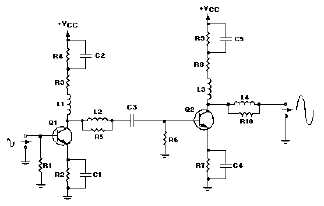6
1-44. What is the arrangement of both "series"
and "shunt" peaking components called?
1. Coordinated
2. Combination
3. Combined
4. Complex
1-45. Which of the following components in a
transistor amplifier circuit tends to limit
the low-frequency response of the
amplifier?
1. The transistor
2. The load resistor
3. The coupling capacitor
4. The input-signal-developing resistor
Figure 1B.—Video Amplifier.
IN ANSWERING QUESTIONS 1-46
THROUGH 1-52, REFER TO FIGURE 1B.
1-46. What is the purpose of L1 in relation to
Q1?
1. Decoupling
2. Shunt peaking
3. Series peaking
4. Input-signal developing
1-47. What is the purpose of C4 in relation to
Q2?
1. Decoupling (Bypass)
2. Shunt peaking
3. Series peaking
4. Input-signal developing
1-48. What is the purpose of R4 in relation to
Q1?
1. Coupling resistor
2. Input-signal developing
3. Low-frequency compensation
4. High-frequency compensation
1-49. What is the purpose of L4 in relation to
Q2?
1. Coupling
2. Decoupling
3. Shunt peaking
4. Series peaking
1-50. What is the purpose of R10 in relation to
Q2?
1. Swamping
2. Input-signal developing
3. Low-frequency compensation
4. High-frequency compensation
1-51. Which of the following components
is/are used for high-frequency
compensation for Q2?
1.
C4
2.
L3
3.
R9
4. All of the above
1-52. Which of the following components
is/are used for low-frequency
compensation for Q1?
1.
C1
2.
C2
3.
R3
4. All of the above
1-53. What is the effect of the gain of an
amplifier if the input-signal developing
impedance is decreased?
1. It decreases
2. It increases
3. It remains the same
4. It cannot be determined

